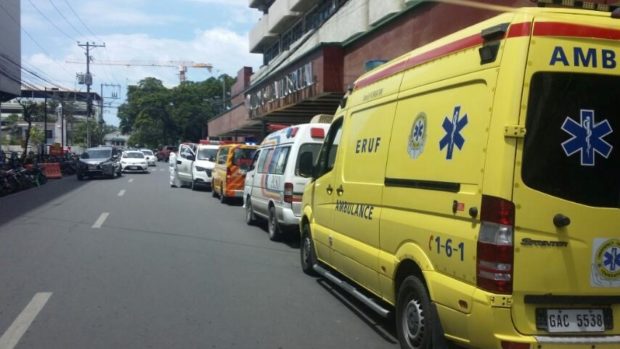
Ambulances carrying patients with severe symptoms of COVID-19 queue at the Chong Hua Hospital in Cebu City so they can be attended to by physicians at the emergency room. (CONTRIBUTED PHOTO)
MANILA, Philippines — The government is now observing the impact of the highly transmissible Delta variant of COVID-19 on a national scale, the Department of Health said Wednesday as it noted a sharp increase in cases since the end of July.
Dr. Alethea De Guzman, OIC-Director of the DOH Epidemiology Bureau, said “the impact of the Delta variant is now observed nationally and in select regions and areas.”
“Half of the provinces, HUCs (highly-urbanized cities), and ICCs (Independent Component Cities) are already showing an increase in cases and/or health care utilization,” she told a town hall session organized by Go Negosyo and participated in by the public and private sector online.
“Given the ongoing Delta VOC (variant of concern) transmission, we need to immediately address observed case increases, closely monitor healthcare utilization, and consider implementing higher community quarantine as pre-emptive measures to contain the Delta variant spread,” she added.
The DOH has yet to declare a community transmission of the variant for lack of evidence, though it conceded that it would be better to assume that there already is.
According to De Guzman, the country saw an average of 7,239 daily COVID-19 cases from July 28 to August 3, higher than the 6,303 average cases from July 21 to 27, 5,183 cases from July 14 to 20, and 5,144 cases from July 7 to 13.
LOOK: List of areas under moderate to high risk classification for COVID-19 cases according to DOH. @inquirerdotnet pic.twitter.com/c2NlWpcCeF
— Cathrine Gonzales (@cgonzalesINQ) August 4, 2021
De Guzman said Metro Manila and the adjacent provinces — collectively called NCR Plus — are seeing a “steep increase” in cases, while the rest of Luzon and Visayas are exhibiting a slower case increase, and Mindanao is having a plateau in infections.
The country’s risk classification remains at a moderate level based on cases’ two-week growth rate and average daily attack rate. Risk classification is high in Metro Manila, Ilocos Region, Cagayan Valley, Central Visayas, Northern Mindanao, and Cordillera Administrative Region.
Meanwhile, Central Luzon, Western Visayas, Soccsksargen, and Calabarzon are under moderate risk classification. The rest of the regions are under low risk, while the Bangsamoro Autonomous Region in Muslim Mindanao is at minimal risk, according to De Guzman.
De Guzman said all provinces in the NCR Plus are also at an upward trend in cases, with Cavite, Bulacan, and Laguna—all at high risk—having the “steepest” rise in cases. Rizal, meanwhile, is at moderate risk. She noted that all these provinces have cases of the Delta variant.
The country has 63,137 active COVID-19 cases as of Tuesday. So far, a total of 216 cases of the Delta variant, including 17 active cases, have been confirmed in the country.